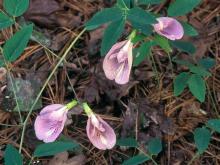Wildflowers, Grasses and Other Nonwoody Plants
Media

Species Types
Scientific Name
Securigera varia (formerly Coronilla varia)
Description
In summer, you’re almost guaranteed to see big colonies of crown vetch along Missouri's highways. This weedy nonnative plant stabilizes the dirt after road construction but degrades our natural ecosystems.
Media

Species Types
Scientific Name
Kummerowia stipulacea (formerly Lespedeza stipulacea)
Description
Korean lespedeza is an Asian clover that was introduced to North America to prevent erosion, to feed wildlife and livestock, and, since it is a legume, to add nitrogen to the soil. A weedy plant, it has spread statewide since the 1930s.
Media

Species Types
Scientific Name
Thalictrum thalictroides
Description
Rue anemone is a common and beloved spring wildflower. It blooms March–June. It and other woodland wildflowers require a forest habitat to survive, so they depend on the oaks, hickories, maples, and other trees that surround them.
Media

Species Types
Scientific Name
Dicentra cucullaria
Description
Dutchman’s breeches, a common spring wildflower, is easy to identify. Note its bluish-green, fernlike leaves and its leafless stalks, from which dangle several white flowers shaped like old-fashioned knee breeches.
Media

Species Types
Scientific Name
Pueraria montana
Description
Of the many invasive nonnative plants that were originally introduced to stop soil erosion and improve soils, kudzu is one of the worst. This “vine that ate the South” is often the first plant that comes to mind when we think of “invasive plants.”
Media

Species Types
Scientific Name
Lespedeza virginica
Description
A bushy native perennial legume with small clusters of pink flowers, slender bush clover provides nectar for numerous insects. Several types of birds eat the seeds, and many mammals eat the foliage.
Species Types
Scientific Name
Lespedeza thunbergii
Description
Thunberg’s lespedeza is a large, nonwoody perennial shrub often cultivated as a showy, flowering ornamental. It sometimes escapes from cultivation and naturalizes in Missouri landscapes.
Media

Species Types
Scientific Name
Daucus carota
Description
Queen Anne’s lace is many things to many people — roadside wildflower, noxious introduced weed, wild edible, medicinal herb, delightful cut flower. In Missouri, it blooms May through October.
Media

Species Types
Scientific Name
Clitoria mariana
Description
Butterfly pea is a low, shrubby, or twining perennial in the pea family, with showy, butterfly-like flowers. The leaves are compound with three leaflets. This species grows in the southern parts of Missouri, in acid soils.
Media

Species Types
Scientific Name
Lathyrus latifolius
Description
Everlasting pea is an old-fashioned garden plant your grandma might have grown on a fence. Native to the Old World, it often persists at old homesites.
See Also
About Wildflowers, Grasses and Other Nonwoody Plants in Missouri
A very simple way of thinking about the green world is to divide the vascular plants into two groups: woody and nonwoody (or herbaceous). But this is an artificial division; many plant families include some species that are woody and some that are not. The diversity of nonwoody vascular plants is staggering! Think of all the ferns, grasses, sedges, lilies, peas, sunflowers, nightshades, milkweeds, mustards, mints, and mallows — weeds and wildflowers — and many more!





















